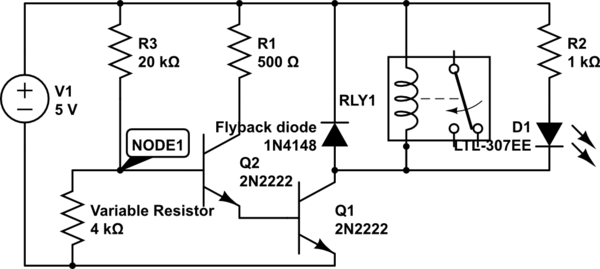I'm building a circuit that can turn on a relay when the variable resistor cools down.
Its operating principle is cooling down the variable resistor increases its resistance, causing the voltage at Node 1 to increase until BJT 2 turns on, driving BJT 1, driving the relay. The LED is there as a visual indicator.

simulate this circuit – Schematic created using CircuitLab
However, when I built, I observed some strange behavior: upon cooling the variable resistor, after about 2 seconds the LED begins to glow and over the next second increases in brightness. Then, when the relay turns on, instead of a single "click", over the next second I hear a buzzing sound as the relay oscillates on and off before staying turned on.
When turning off (letting the variable resistor warm up), first the LED begins to grow dim, and then the relay, instead of cleanly turning off, oscillates for a second before remaining open. Moreover, when the relay is bouncing, the LED grows very slightly brighter (I don't think this is just my imagination).
My current understanding of the circuit is that as the resistance of the Variable Resistor increases, the current is amplified by the two transistors and gradually increases the current flowing through the relay until it turns on. While I know that relays can experience contact bounce, especially when run at less than rated voltage, I have no idea why it should oscillate for so long, or why the LED should grow brighter.
What circuit effect is responsible for the relay bouncing for so long?
